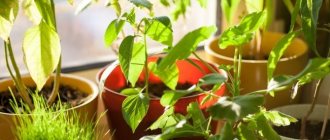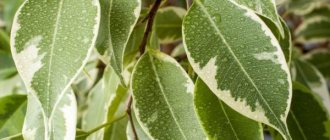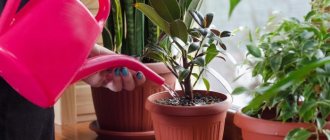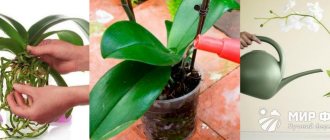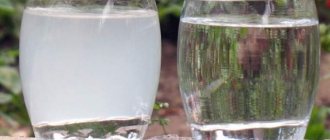There are a few details you need to know before getting green pets. Many lovers are interested in the question of how often to water flowers. In addition, there are still a huge number of recommendations for care: lighting, feeding, air temperature and much more. And yet, the lifespan of a plant depends primarily on watering. However, not all plants need watering, as do the other factors above. And for some, it is enough just to maintain relative regularity of soil moisture so that they feel good and are healthy. Such plants are considered the most practical. All you need is to feed the flowers with moisture in a timely and moderate manner, ensuring beauty on the windowsill. But do not overdo it, so as not to flood the plant.
The plants most prone to death from excess moisture are bulbous plants and succulents.
Watering indoor plants in spring, summer, autumn and winter
Each season has an individual effect on plants. Therefore, we will analyze watering options depending on the season.
- In summer, plants need plenty of moisture. Just like people, they are hot and thirsty. Especially if your plant is located on the south side and is exposed to excessive sunlight almost all day long. In some areas, the sun's rays have a beneficial effect on flowers, but there are places where the air temperature exceeds 30 degrees or more. In this case, the plant must be moved to a more shaded place. If there is no such place, then monitor the soil moisture of your plant daily.
- In autumn, plants begin to experience vitamin deficiency, and they need to be fed occasionally with special fertilizers. At this time of year, you need to be as careful as possible so as not to overdo it with watering. Once a month will be enough. Because the air becomes cold and dry, the soil takes a very long time to dry out, which does not have a very good effect on the plants. In this case, the soil should not be allowed to dry out completely.
- In winter, plants prefer water at room temperature. Watering is required much less often than in spring and summer, approximately once every two weeks. Because plants begin a so-called dormant or hibernation period. They are less active at this time of year, which means their growth and appetite for water is reduced.
- Spring is a time of awakening. Therefore, indoor plants wake up and are fed up with the spring sun, which produces biological activity in them - photosynthesis. It is believed that spring is the best and most fruitful time for green people. This is due to the fact that the sun's rays are the most favorable during this period. Still, it is important to ensure that the plant changes its location, since prolonged exposure to ultraviolet radiation threatens drought.
Why is it important to use suitable water for irrigation?
The composition of water affects the digestibility of elements, the condition of the soil and the vital activity of beneficial microorganisms.
For example, a high content of calcium and magnesium salts or hardness leads to disturbances in phosphorus metabolism.
When watered for a long time with hard water, plants slow down in growth , do not bloom and throw out weak shoots. Phosphorus depletion occurs due to the formation of insoluble mineral complexes.
Also, excess mineral salts pollute the upper layers of the soil. As a result, the roots receive nutrients in a smaller volume than is introduced during feeding.
When to water indoor flowers: time of day to water houseplants
Before buying potted plants, you should consult with a flower shop employee about what conditions need to be created for the plant to take root in your home. These conditions include when and with what frequency to water the soil. It is best to do this in the morning. Then, the soil will have time during the day for the moisture to evaporate. And if you water the plant in the evening or closer to night, then there is a risk that it will begin to hurt and die due to rotting and hypothermia of the root system. This happens because moisture stagnates in the soil for too long. At night, the plant is deprived of sunlight, so the soil will dry out much longer.
What time of day - morning or evening?
Watering in the morning is preferable at almost any time of the year:
- in the summer, so that the substrate does not dry out in a day, and the leaves do not wither from excessive evaporation;
- on south windows at any time;
- in winter, so that the plants have time to absorb moisture during the daylight hours, and the roots do not become overcooled at night from excess moisture;
- in spring and autumn, when temperature changes in the room are possible: excess moisture evaporates, condensation settles on the leaves, which provokes bacterial diseases; at low temperatures, rot may occur on the surface of the soil around the flower.
Daytime watering is desirable for plants with large leaves, as well as flowers native to the subtropics. Varieties of such flowers, bred artificially, retain the need for daytime moisture. Most often, at this time, the leaves are sprayed or wiped to prevent wilting.
Evening watering is recommended as additional watering in dry microclimates. In cases where the gardener decides to water the flowers for some reason, lighting should be provided for 2-3 hours after the procedure. This will allow the plants to absorb excess moisture from the substrate before going dormant at night.
Factors influencing the irrigation regime
- The frequency and volume of watering is greatly influenced by the size of the plant. If it is large, it consumes more liquid, since its roots are more massive and absorb a lot of liquid.
It is especially important to take into account the fact that the plant needs to be replanted if you see that the ratio of its dimensions to the size of the pot is not equal.
- In the summer, at the height of the heat, it is also necessary to ensure that the plant consumes a sufficient amount of moisture. In this sense, they are very similar to us - people. When we are hot, we experience extreme thirst. So think about it. Without regular watering in the summer, the plant experiences great stress.
- Cold season and high humidity. This means that watering needs to be reduced.
Dependence on the time of year
In addition to the time of year, be sure to take into account the parameters of the microclimate in the room .
It can be hot in apartments and rooms of private houses in the summer when the owners are absent, since the air conditioners and split systems are turned off.
In these cases, watering is carried out in the morning and the moisture status is monitored in the evening; if necessary, additional water is added.
At the same time , apartments and houses are dry in winter . In these conditions, spraying the leaves in the middle of the day works well. In winter gardens and greenhouses, temperature fluctuations are observed - it is undesirable to carry out evening watering in such conditions.
How to water flowers correctly
It is imperative to use pre-settled water, the temperature of which will be 2-3 degrees above room temperature. The water needs to stand for at least a day. Especially in urban areas, where the water is most chlorinated. Tap water is not settled water and is considered hard, in the truest sense of the word. In winter, when plants stop growing, dry watering is used: they are watered less often, the soil in the pots is loosened more often so that air can better flow to the roots, and the foliage and inflorescences are sprayed.
There are also two conventional types of irrigation, which we will now consider.
Which is better - top or bottom watering?
The most common and traditional method is overhead watering. Thus, the plants are more evenly saturated with moisture. Bulbous plants prefer top watering most of all, as they are susceptible to dampening. But do not forget that if you water a plant in this way, you need to distribute the liquid throughout the soil, because small holes may form due to soil erosion. However, some plants have their own characteristics: then it is necessary to use the bottom watering method. This method is practiced much less frequently. There are some plants whose leaves should never be exposed to water. Then their owners, in order to be on the safe side and not destroy their green friend, resort to spilling soil from below. After some time, you can notice that a white sediment has formed on the top layer of soil.
This is a signal that you neglected to water the pan, since with this method, mineral substances often come to the surface, which also does not have the most favorable effect on the plant.
Liquid volume
Each house plant needs the amount of moisture consumed that is characteristic of it. There are three types of watering:
- Limited is best suited for drought-tolerant plants. For example, cactus, dracaena and succulent.
- Moderate is used when only part of the soil dries out. The plant needs to be moistened so that the water flows into the pan. It must not be allowed to remain in it, so after a spill it must be drained.
- Abundant is suitable for large plants living in a large pot and natives of swampy areas.
Before calculating fluid volume, check the recommendations that apply to your plant.
How to save a flooded indoor flower
When you have determined that the plant has been flooded, you need to take immediate action. If you establish the fact of waterlogging after removing the plant from the pot, then you will have to replant. If the fact of waterlogging is determined by indirect signs (falling leaves, damp soil to the touch), then the need for replanting depends on the severity of the situation.
If the plant has lost one or two leaves, or one branch in the mighty crown has withered, and the soil in the pot is quite light, then you do not need to replant the plant, but only loosen the soil. After watering, especially abundantly, the soil spreads out, and after drying, a dense crust forms on its surface. If this crust is not destroyed, the roots suffer from lack of air. If seed plantings are watered, the seedlings may not reach the surface of the earth and die from hypoxia.
If the pot has small drainage holes, you can widen them or increase their number without removing the plant from the pot, using a knife heated on the stove.
I never try to just loosen the soil, it is not very reliable and justified in cases where the plant is flooded in a very large pot, replanting is difficult, or when the plant is transferred from a cold room to a warm one, and the very increase in temperature will speed up the drying of the soil.
In all other cases, it is better to replant the plant. Inspect the roots. Rotten ones can be seen immediately - they separate, if you grab the root with two fingers and pull, the skin slides off it - it is brown or dark gray, underneath it there remains a bundle of vessels that looks like a wire, a hard rod. If such separation occurs, the root is rotten. Healthy roots do not separate; if you run your fingers over the surface, the top layer will not come off. In some cases, the roots do not exfoliate, the fleshy, succulent roots rot completely, and this is also immediately visible - they are dark, dirty gray or brown, sometimes softened. You can often identify healthy roots and rotten ones by the contrast in appearance: some are light, white, light brown, others are dark, not only on the outside, but also on broken or broken areas.
Latest articles about gardening
Black currant: planting and care in autumn
Black currant planting and care in autumn
Schefflera. Flower: home care, pruning
There are times when rotten roots break off easily and, when the plant is removed from the pot, fall off along with the soil. If you haven’t found any definitely rotten roots, but the soil and root ball are damp, you need to dry them. To do this, we soak the measles lump in any hygroscopic material: in a pile of old newspapers, in a roll of toilet paper. You can even let the plant with its root system exposed (without a pot) dry for several hours.
Having discovered rotten roots, you need to cut them off, no matter how many there are. This is a source of infection, there is nothing to regret here. We cut everything down to healthy tissue. If the roots are fleshy, juicy, watery, then it is advisable to sprinkle the cut areas with charcoal (charcoal, birch) or sulfur powder (sold in pet stores). If there is neither one nor the other, crush an activated carbon tablet. If there are very few roots left, much less than there were, you need to transplant the plant into a smaller pot.
Improper watering: signs and their elimination
The most common cause of plant death is improper watering. It is either excessive or insufficient.
- With excessive watering, you can observe the formation of mold on the surface of the soil.
- The edges of the leaves are predominantly brownish and black. They dry out and become brittle.
- Plant growth slows down.
- Leaves become yellow and limp.
- The buds of flowering plants wither and fall off.
Is it possible to revive a dried out houseplant?
In order not to bring the plant into a sad state, it is important to take proper care of its health in advance. Before restoring the plant, do not rush to flood it as thoroughly as possible. This will most likely have an even more detrimental effect on his condition, because he is unaccustomed to proper moisture intake and simply will not be able to cope with large amounts of liquid.
First of all, be patient and set aside free time for resuscitation. There are effective ways to bring the plant back to its previous shape:
- If moisture has a positive effect on the leaves, then start spraying it with mineral water.
- You can also put a wet sponge in the soil, which in turn will release liquid as needed for the plant.
- Assess the condition of the root system. To do this, you will need to remove the plant from the soil and replant it in a new one, if necessary.
- Feed the plant with mineral fertilizers.
What to do if the flower is flooded
- In this case, it is necessary to urgently remove the plant from the soil and replant it into a new one, with high-quality drainage and holes for it in the pot.
- Initially, you need to rinse the roots in water.
- Before transplanting, it is important to carefully examine the roots for disease.
- We remove the most affected areas and use activated carbon powder as a disinfectant, lubricating the cut areas with it.
- Now that the plant is ready for replanting, we place it in a new pot with soil that has already been replaced.
In addition to the above conditions, take care of the air temperature and lighting. This will also play a big role in his return to life.
Methods for automatically watering flowers
Flowers that love water can be moistened during their long absence using automatic watering. To do this, the following methods are used that will answer the question of how to water flowers during vacation:
- wick;
- plastic bottles;
- pallet with expanded clay;
- plastic bags;
- medical droppers;
- hydrogel;
- mats;
- automatic pots;
- flasks for humidification;
- ready-made automatic watering systems.
Any of these methods must be tested first. This way you can choose the right portion of water that your flowering pet needs for good growth. Also carefully study all the advantages and methods of each method. For example, the greenhouse method of plastic bags with water can lead to mold and mildew, and hydrogel requires a complete replanting. The best way would be a ready-made auto system, but it is expensive.
What determines a plant’s need for moisture?
The plant's need for watering depends on a number of factors:
- Weather.
- The degree of power of the root system.
- Development phase.
- Capacity size.
- Lighting.
Please note that the moisture needs of each houseplant are individual. You cannot use the same watering method for absolutely all the plants in your home. Often, a lack of moisture can be indicated by drooping leaves and dry lumps of earth on the surface of the soil, and dried out buds of inflorescences. If you are unable to independently determine how saturated the soil is with moisture, you can use an unusual, but very convenient method. Try purchasing a special device in the form of a thermometer that will determine the level of moisture in the soil by placing it at the depth specified according to the instructions. It is especially important to purchase such indicators for more demanding plants. Because, in addition to soil moisture, it determines the condition of the root system.
We hope that our article helped you and your plants will always be healthy. Use the methods we described to revive plants if you still encounter a problem. Follow your watering schedule. Explore the ins and outs of your houseplants. And then in return they will delight you with an excellent view.
How do soil moisture indicators work?
A soil moisture indicator is an inexpensive but very practical device that shows how much moisture the substrate contains. Costs from 100 to 300 rubles.
The indicator is used as follows:
- stuck several centimeters into the ground;
- follow his instructions;
- If the indicator shows that there is not enough moisture in the soil (usually it turns red), water the flower.
Important: Be very careful when installing the device in the ground. The fact is that during the procedure it is very easy to touch the roots, and this can cause disease or even death of the flower. The optimal solution is to place the device in the pot at the same time as planting. True, such an opportunity is not always available.
What to do if you are too dry?
Watering dried flowers is done by immersion. This way you can evenly moisten the soil.
Step by step steps:
- We prepare a container with water, its temperature is from 25 to 30 degrees, more than the size of the pot.
- Place the pot with the plant there for 5-10 minutes.
- If the plant has suffered greatly from overdrying, then the pot should be kept in water until air bubbles stop being released.
- Remove the flower pot from the container.
- Let the water drain.
Note, if after watering the leaves of a wilted flower become elastic, then the plant suffered from overdrying.
The video will tell you what to do if the plant is too dry:
Spraying rules
Here are a few simple rules that will help you avoid problems when spraying indoor flowers:
- do not spray the plants in the morning - drops of water can refract bright sunlight and burn the leaves;
- Don't apply too much moisture - everything is fine in moderation;
- for spraying, use only stabilized water;
- add nutrients to the spraying liquid (many people use simple hydrogen peroxide for this - 5-6 drops per liter of water is enough).
Important: If you don't have the opportunity to spray during the day or evening, simply remove the plants from a sunny windowsill and moisten them. This will protect them from negative consequences.
